Clongowna House
Houses within 15km of this house
Displaying 97 houses.
Houses within 15km of Clongowna House
Displaying 97 houses.
| House name | Description | |
|---|---|---|
| Portumna | Reverend Lewis Hawkes was leasing a property at Portumna, valued at £16 from the Ecclesiasical Commissioners at the time of Griffith's Valuation. The Reverend Louis Hawkes of Brierfield died in 1857. A house still exists at the site. | |
| Grange | The Earl of Huntington's estate in Galway included a house valued at £7 at Grange, parish of Killeenadeema, leased to Patrick Murphy. A house labelled Grange House appears on the 1st edition Ordnance Survey map. On the 25-inch edition of the1890s the original house is not shown and Grange House is located at M878146. This house is now a ruin. | |
| Tully | Joseph Cowan leased lands and a house valued at £7 at Tully to Matthew Madden in 1856. In 1906 Tully was the property of Stephen Cowan and still valued at £7. It is still extant and occupied. |

|
| Cappaluane Glebe | Rev. Richard Eyre was leasing the Glebe house at Cappaluane, barony of Longford, from the Ecclesiastical Commissioners at the time of Griffith's Valuation when it was valued at £18. He was also leasing land from John Eyre. Cappaluane Glebe is still extant and occupied. In 2006 it was offered for sale. |

|
| Eyrecourt Castle | Eyrecourt Castle was originally built in the 1660s. In 1786 Wilson refers to it as "the fine seat of Lord Eyre, with ample demesnes". It is mentioned as a gentleman's seat in the Ordnance Survey Name Books in the 1830s. It was held in fee by John Eyre at the time of Griffith's Valuation when it was valued at £48. A fine lithograph of the Castle appears in the Encumbered Estates schedule when the estate was offered for sale in June 1854. The castle itself is now in ruins. The fine oak staircase is now in the Detroit Institute of Arts. Substantial evidence of the demesne still remains. |

|
| Fearmore House | In 1856 Edward Horsman was leasing a house in the townland of Fearmore from the Clanricarde estate. It was valued at almost £9 at the time. It is still extant and occupied. |
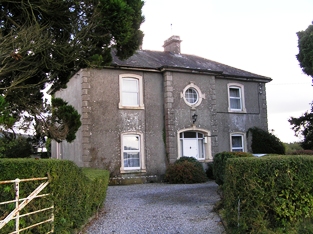
|
| Redmounthill Farm | At the time of Griffith's Valuation the property at Ballynamudagh, a steward's house and out buildings valued at £14, were part of the Pollok estate. In 1906 this property was valued at £41. On the 25-inch Ordnance Survey map of the 1890s the buildings are labelled Redmounthill Farm. The house and some portions of the farm buildings remain at the site. |

|
| Woodview | In the 1830s a "gentleman's residence" named Woodview already existed here. Slater notes it as the seat of Richard G. Daly in 1846. At the time of Griffith's Valuation Richard Eyre was leasing this property from Richard G. Daly. By 1906 this house had become part of the Pollok estate and was valued at £10. The house is still extant and occupied. |

|
| Woburn | A "gentleman's seat" called Waburn is recorded here in the Ordnance Survey Name Books of the 1830s. Slater refers to Woburn as the seat of Henry Flanagan in 1846. Buildings in this townland valued at £15 were leased by Henry Flanagan from the Clanricarde estate in 1856. Woburn is still extant though disused. |
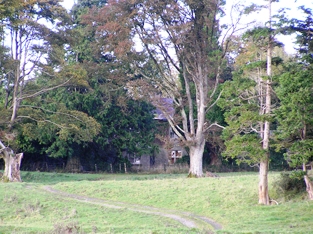
|
| Moorfield House | In 1778and 1786, this house was the residence of the Blake family. Moorfield was a steward's house on the Eyre estate at the time of Griffith's Valuation. In April 1869 the Eyre's Moorfield estate, including the house, was offered for sale in the Landed Estates court. In 1906 it was owned by James Howard Jnr and was valued at £28. The National Inventory of Architectural Heritage suggests that the extant house at Moorfield is of late nineteenth century date. |
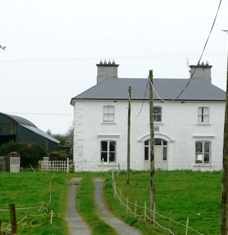
|
| Earlstown | In 1786 Wilson refers to "Capasell" s the seat of Mr. Devenish [?]. The house at this location is labelled Earlstown on the 1st edition Ordnance Survey map. In 1846 Slater refers to Robert Grace resident at Earlston. Robert Eyre was leasing a property in the townland of Cappasallagh, parish of Kilmalinogue, barony of Longford, valued at £11 from the Clanricarde estate in 1856. There are still occupied buildings at this site, the focus of a large farming enterprise. |

|
| Corr Lodge/Corr House | At the time of Griffith's Valuation the property at Corr was being leased by R.P.Dolphin to Edmund Mahon. In the 1780s, both Taylor and Skinner and Wilson recorded Corr as a seat of the Dolphin family. Slater refers to it as the seat of Redmond D. in 1846. By the 1890s it had become known as Corr House. In 1906, the mansion house at Corr, valued at £15, was owned by Marcella Blake Forster. It is no longer extant. |
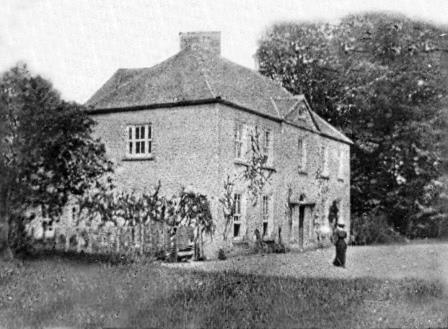
|
| Derryhivney House/Harding Grove | Wilson may be referring to this property when he mentions the ruins of a castle at "Derryborn" and the seat of Mr. Hind. In 1814 this house was known as Harding Grove and was the seat of Jonathan Harding. It appears under this title on the 1st edition Ordnance Survey map. The Harding family also had an estate in north Tipperary. In 1846 Slater refers to "Derryhiney" as the seat of Cuthbert Fetherston. At the time of Griffith's Valuation, the house at Derryhivney was occupied by him. On the 25-inch map of the 1890s it is labelled Derryhivney House. David England Young of Ballygibbon, county Tipperary and Harding Grove, county Galway is recorded in Walfords (1910). |

|
| Prospect (Meelick) | In 1856 Joseph Cowan was leasing a property at Prospect, in the parish of Meelick, barony of Longford, from Francis Usher. In 1837 Lewis recorded Prospect as the seat of C.A. O'Malley. Slater refers to it as the seat of John Smith in 1846. In 1906 Prospect was the property of Ernest Kenny and valued at £12. In 1778 and 1786, this property was the residence of the French family. Prospect House is still extant and occupied. |
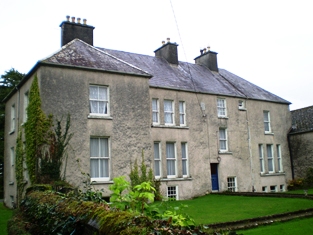
|
| Kilquain | At the time of Griffith's Valuation Allen Pollok held a property in Kilquain valued at £5 10s which was used as a steward's house. There is evidence of estate architecture in the vicinity but twentieth century buildings on site. | |
| Gurtray/Gortrea/Gortray/Fairfield | Writing in 1786 Wilson refers to this house as Fairfield, the seat of Mr. Hamilton. Ambrose O'Kelly was the owner of a house valued at £20 in Gortrea or Fairfield, parish of Kilmalinoge, barony of Longford, county Galway in 1856. Slater refers to "Gurtray" as the seat of John Appleyard O'Kelly in 1894. In 1906 this house was the property of John A. O'Kelly. According to family tradition the house lost its roof on the Night of the Big Wind in 1839. It is still extant and occupied and in 2007 was offered for sale. |

|
| Fairy Hill | Thomas Doolan was leasing a property at Fairy Hill, valued at £20, to Charles Cooper at the time of Griffith's Valuation. Slater had noted it as the residence of Thomas Doolan in 1846. In 1894 Slater records Fairy Hill as the seat of Colonel Cheevers. This house is still extant. |
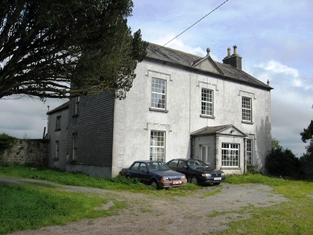
|
| Palmerstown ( Pokoroko) | In 1814 a house at Fairy Hill was the residence of Mr. Palmer. This property was held on a lease renewable forever from the Clanricarde estate. It is recorded in Lewis under Portumna town. In 1865 it was occupied by Lewis Goodbody who had purchased it in the Landed Estates Court in 1861. The sale notice refers to the house as "Pokoroko" and this title appears again in the Cunningham sale report of June 1886. However on both the 1st and 25-inch editions of the Ordnance Survey map it is labelled Palmerstown House, the name by which it is still known. It is still extant and occupied. |

|
| Gortaha House | Cuthbert Featherston held a property valued at £10 in the townland of Gortaha, parish of Lickmolassy, barony of Longford, in 1856. It is labelled Gortaha House on the 1st edition Ordnance Survey Map. The 25-inch map of the 1890s records that it was "in ruins" and very little now remains. | |
| Willmount or Gortnacloghy | In 1856 Matthew McDonagh was leasing a property valued at £19 in the townland of Gortnacloghy, parish of Lickmolassy, barony of Longford, from the Clanricarde estate. This house was also known as Wilmount or Wellmount. |

|
| Oakley Park | At the time of Griffith's Valuation, John Cunningham was leasing a house valued at £13 at Gowil, parish of Lickmolassy, from Anne Shewbridge. This appears to be the house known as Oakley Park, occupied in the 1870s by the Pigot family. It is still extant and occupied. |

|
| Ormond View | The representatives of Redmond Dolphin were leasing a property at Ballycrossaun, barony of Longford, to John D. Lemon at the time of Griffith's Valuation when it was valued at £12. Slater notes this property as the seat of Joseph Lemon in 1846. Hogan states that this house was formerly known as Waterview. Ormond View is still extant and occupied. |
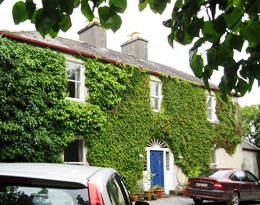
|
| Longford Lodge | In 1846 Slater refers to Patrick and Stephen Kelly, both of "Longford House". Patrick Kelly was occupying the house at Gortadullisk, barony of Longford at the time of Griffith's Valuation. In 1837 Lewis had recorded Longford Lodge as the home of a Major Kelly. In 1906 it was owned by Denis Kelly and was valued at almost £15. It is no longer extant though part of the walled garden remains. |

|
| Greenfield/ Fahy | In 1777 a house at Fahy is recorded by Taylor and Skinner as a Hamilton residence. In 1786 Wilson mentions Faghy as the seat of Mr. Hamilton. Lewis records Fahy as the seat of T. Burke in 1837. The OS Name Books state that the gentleman's residence in the townland of Fahy was called Greenfield. At the time of Griffith's Valuation, Pierce Joyce held over 400 acres of this townland together with buildings valued at over £6. The house is labelled Greenfield on both the 1st and 25-inch Ordnance Survey maps. Some ruins survive at the site. | |
| Lismore Castle | In 1778 Lismore Castle was the residence of the Daly family. Wilson refers it as the seat of Anthony Daly in 1786. It is described as "in ruins" on 25-inch Ordnance Survey map of the 1890s. Some elements of the demesne are still visible. |

|
| Quainsborough/Quansbury Lodge/Stowlin | Originally a Daly house. In 1783 Taylor and Skinner and Wilson, in 1786, record Queensborough as a seat of the Earl of Louth. Slater refers to Quansborough Lodges as the seat of William B. Burke in 1846. Mentioned in the sale notice for portion of the St. George estate in November 1853. John P Watson was the occupier of a house valued at £13 in the townland of Stowlin, parish of Kilquain, barony of Longford, in 1856. In 1906 this house was owned by Kate Watson and was valued at £33. Buildings are still extant at site though may have been modernised. The Clonbrock Estate Papers, Collection List 54 in the National Library contain early 19th century rentals of the Quansbury estate. In many documents the name of this house is spelt Quansbury but on the Ordnance Survey maps it is spelt Quainsborough. |
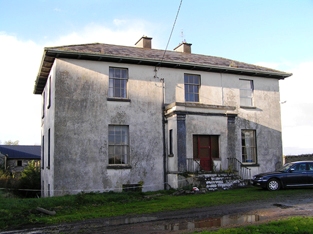
|
| St. Brendan's | Archdeacon Butson is listed as the occupier of the house in Glebe townland in 1855 when it was valued at £25. It is labelled St. Brendan's on both the 1st and 25-inch edition Ordnance Survey Maps. This house is no longer extant. |
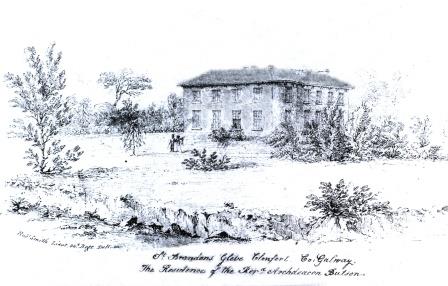
|
| Abbeyland Cottage | A herd's house in the townland of Abbeyland Great, parish of Clonfert, barony of Longford, was part of Archdeacon Butson's estate. It was valued at £1 10 at the time of Griffith's Valuation and leased to John Kenny. This house is no longer extant. | |
| Abbeyland House | Archdeacon Butson was leasing a steward's house, valued at £8, in the townland of Abbeyland Great, parish of Clonfert, barony of Longford, to Allan Pollok, at the time of Griffith's Valuation. Buildings still exist at the site. | |
| Cloonconra | A house in the townland of Cloonconra, parish of Clonfert, barony of Longford, was valued at £10. It was part of Archdeacon Butson's estate at the time of Griffith's Valuation. It is labelled Cloonconra Farm on the 25-inch Ordnance Survey map of the 1890s. A farm still exists at the site. | |
| Clonfert Palace | Clonfert Palace was built in the late 17th century and altered in the 18th century. It was the residence of the Church of Ireland bishop of Clonfert until 1836 when that diocese was amalgamated with Killaloe. At the time of Griffith's Valuation, John E. Trench was leasing the property valued at £20 from the Ecclesiastical Commissioners in the townland of Clonfert Demesne, barony of Longford, county Galway. In 1906 it was in the ownership of Charles O'Hara Trench. Later occupied by the British fascist leader, Oswald Mosley. It was damaged by fire in 1954 and has been derelict since. |
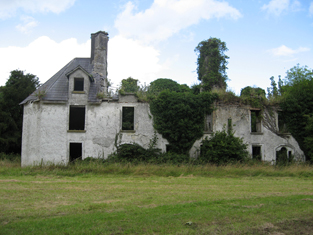
|
| Clonfert Cottage | In 1855, a house valued at £8 and belonging to the representatives of Robert Seymour, was leased by James Buchanan. Slater refers to "Clonfert Cottage" as the residence of Robert Seymour in 1846. On the 25-inch maps of 1890s the property at this site is labelled "Constabulary Barracks". | |
| Cloonkea | John Eyre was leasing a house valued at £10 from the estate of Dr. Duggan in 1855. The house was located at Cloonkea, barony of Longford. It was advertised for sale in 2007. |
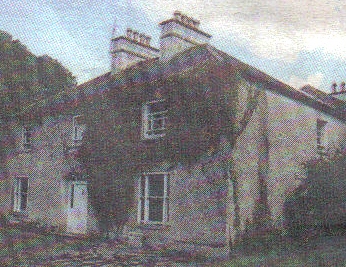
|
| Lismore | Henry Kenny was leasing a property valued at £8 from Lord Dunsandle in 1855. It was located at Lismore Demesne, parish of Clonfert. Lismore Castle is shown there on the 1st edition Ordnance Survey map. By the 1890s this building is in ruins but Lismore Farm (M943160) is located nearby. Ruins of both buildings are still visible at the site. MacLysaght, in his 1944 report on the Dunsandle papers, notes the existence of deeds relating to Fergus Madden of Lismore. | |
| Hemmings Ville | The representatives of Robert Seymour were leasing a house valued at £6 and almost to 250 acres to Sidney Smith in 1855. This property is labelled "Hemming's Ville" on both the First and 25-inch editions of the Ordnance Survey maps. There is still an extant house at the site. | |
| Kilnaborris Dower House | John Seymour was leasing a property valued at £8 from Hubert Moore at the time of Griffith's Valuation. It was located in the townland of Kilnaborris, parish of Clonfert. Kilnaborris Dower House is still extant and now offered as holiday accommodation. |
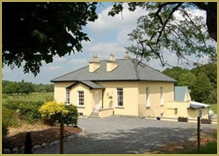
|
| Shannon View | Belinda C. Madden is listed as the lessor of two properties in the townland of Kilnaborris, parish of Clonfert, in 1855. The property which appears to have been known as Shannon View was vacant at this time. It was valued at £12. In July 1889 property at Kilnaborris, or Shannon View was offered for sale in the Land Judges' Court by William C. Bermingham Ruthven. The sale was adjourned. In 1783 Taylor and Skinner had recorded it as a residence of the Madden family. In 1786 Wilson refers to Kilnaborris as the seat of Mr. Madden. The National Inventory of Architectural Heritage suggests the house now extant on the site was built c.1870. It suffered fire damage in the twentieth century but was rebuilt c.2002. The house is now known as Lairakeen. |
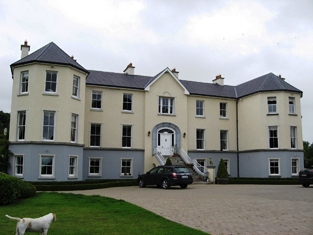
|
| Shannon Grove | Shannon Grove was valued at £20 and was leased to Hubert Moore in 1855. William R. Seton was the owner of a house valued at £65 in the townland of Kilnaborris in 1906. Leet's Directory records Shannon Grove as the residence of Hon. B. Yelverton in 1814. A substantial house still exists at Shannon Grove. |
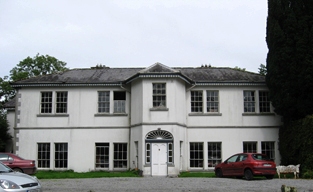
|
| Killeragh | At the time of Griffith's Valuation, Thomas Kenny was occupying a property valued at £5 together with 180 acres, in the townland of Killeragh, parish of Clonfert, barony of Longford. A house is still extant at the site. | |
| Coolcarta Farm | At the time of Griffith's Valuation Allan Pollok held a property valued at £20 in the townland of Annaghcorrib, parish of Clonfert, barony of Longford. It is labelled as Coolcarta Farm on the 25-inch Ordnance Survey map of the 1890s. Padraig Lane states that this property was damaged by fire during land agitation in the 1850s. A substantial farm still exists at the site. | |
| Lisbeg | In 1906 the representatives of John Pollok were in possession of a house and buildings valued at £65 at Lisbeg, parish of Clonfert. At the time of Griffith's Valuation Allen Pollok had owned the townland of 353 acres and a herd's house valued at almost £3. The National Inventory of Architectural Heritage states that it was re-built after a fire in the 1890s and occupied by John Gardiner at that time. It is still extant and occupied. |

|
| Longford House (Tirnascragh) | At the time of Griffith's Valuation, George Kenny was occupying a property valued at almost £7 at Longford. Hogan states that Longford House was built c.1844-1850. It passed from the Kenny family to Major Longbourne in the 1890s but Hogan records that he sold the estate in 1902. In 1906 the Congested Districts Board are recorded as the owners and the house was valued at £12 at the time. It passed to the Stoddart family in 1914 and is still extant and occupied. |

|
| Lissanacody | The Pollok estate held a steward and caretakers' houses at Lissanacody, barony of Longford at the time of Griffith's Valuation, valued at £6 between them. In 1906 the property was part of the estate of the John Pollok's representatives and was valued at £7.Molloy writes that these buildings, which were unoccupied at the time, were damaged by fire in 1854. Some farm buildings remain at the site. | |
| Fortmoy House Lower | In 1840 the Ordnance Survey Name books refer to "Fordmoy" as "a good dwellinghouse, lately built, the residence of Mr. Prendergast".This house was vacant at the time of Griffith's Valuation. Thomas G. Prendergast was the immediate lessor and the house was valued at £11. Buildings valued at £27.5 shillings were held by the representatives of David Clarke at Fortmoy in 1906. Fortmoy House Lower is still extant. |
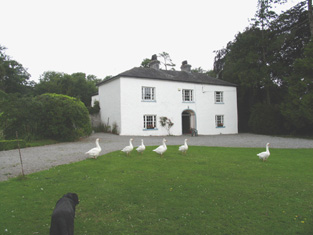
|
| Spring Park | In the mid 19th century Benjamin Armitage occupied a house valued at £10 in Gortnagrann which he held with 243 acres from William Woods. The Ordnance Survey Name Books note it as being occupied by Mr. Armitage in 1841. The site is now occupied by farm buildings. | |
| Milford | Lewis records Milford as the occasional residence of Ralph Smith. By the early 1850s it was occupied by Thomas Bunbury and held from William Woods. Bence Jones writes that it was the home of Edmond Murphy who died in 1882. In 1840, he Ordnance Survey Name Books refer to the house as the residence of John Monsell and describe the demesne as "principally composed of plantation and ornamental grounds". |

|
| Lisbryan | Lisbrien or Lisbryan, near Ballingarry, was occupied by Faulkner Esq in the 1770s and 1780s. Sir Robert Waller Baronet was occupying this house in 1814. Lewis records T. Bunbury as the proprietor in 1837. The Ordnance Survey Name Books, also refer to it as his residence, "a very extensive building of the modern style". Thomas Bunbury held the property from Lord Ashtown at the time of Griffith's Valuation when the buildings were valued at £40+. Lisbryan is still extant. |

|
| Ballymona | Ralph Smith was resident at Ballymona in 1837 and in the early 1850s. The Ordnance Survey Name Books refer to the house as " a plain modern building" in 1841. Smyth held the property from Lord Ashtown and the buildings were valued at £25. This house is now a ruin. | |
| Fairyhill | Fairyhill was the home of William Henry Cox in 1837. The Ordnance Survey Name Books describe it as "a large mansion house, the residence of Mr. Cocks [sic]" in 1841. It was occupied by Ellen Robinson in the early 1850s, when the house was valued at £19 and held from Lord Ashtown. Valued at £16 in 1906 and held by George W. Robinson. This house is still in use as a residence. |

|
| South Park | In the 1770s Abbot Esq was residing at Rahanane close to Ballingarry. Wilson, writing in 1786, also refers to Rahanane as the seat of Mr. Abbott. The house is named South Park on the 1st edition Ordnance Survey map and was the home of a branch of the Atkinson family, occupied by Anthony Atkinson in 1814 and by C. Atkinson in 1837. Charles Atkinson held the property from Lord Ashtown at the time of Griffith's Valuation when the house was valued at £22. The estate of Edward Evans of Southpark, 174 acres in the barony of Lower Ormond, was advertised for sale in December 1859. South Park is still extant. |
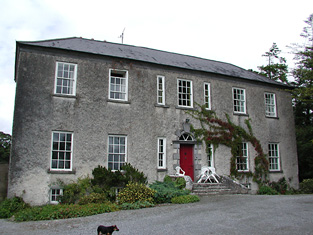
|
| Ballingarry | Situated just north of Ballingarry castle Ballingarry House was built circa 1820. Lewis records Marmaduke Thompson as resident at Ballingarry Castle in 1837 as does the Ordnance Survey Name Books in 1841 though they refer to Lord Ashtown as the proprietor. The Thompson interest in Ballingarry and Ballinahinch was for sale in June 1850. Henry Trench was the occupier in the early 1850s holding the property form Lord Ashtown. Ballingarry House is still extant and occupied. |
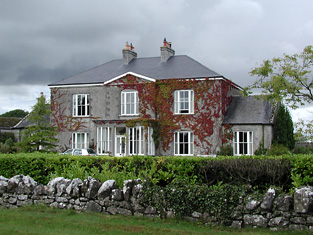
|
| Redwood House | Redwood was the home of the Bloomfield family in county Tipperary, occupied by Major Bloomfield in 1837. In 1840 the Ordnance Survey Name Books mention that Redwood was "a commodious house, at present occupied by a party of the constabulary and also the residence of Mr. Ryan, under-agent to Maj. Bloomfield". It is marked as a police station on the 1st edition Ordnance Survey map. At the time of Griffith's Valuation. Phillip Crawley held the property from Lord Bloomfield and the house was valued at £15. Redwood House later became a Trench home, valued at £18.15 shillings in 1906. It no longer exists. | |
| Lismacrory | An early home of the Smith family in county Tipperary. Lewis writes that Lismacrony was the ancient residence of the family of Smith now the property of Mr Bunbury. This house was in ruins at the time of the first edition Ordnance Survey map. In 1841, the Ordnance Survey Name Books description says "it was a very commodious house of the modern style of architecture with extensive offices attached to it, but it is now falling into ruins, the last occupier was Rev. Mr. Smyth of Ballingarry". | |
| Walsh Park | The home of the Walsh family in the 18th and first half of the 19th centuries. Taylor and Skinner record Walsh Esq as resident at Derrylaghan [Walshpark]. The Ordnance Survey Name Books refer to the demesne as having plantations and ornamental grounds and to the house as "a good dwelling house, the residence of Jonathan Walsh" in 1840. . In the mid 19th century it was occupied by the representatives of Jonathan Walsh who held the property in fee. The house was valued at £33. This house was demolished by the early 20th century. | |
| Derrylahan Park | Bence Jones writes that this house was built in 1862 at a cost of £15,000 to the design of Sir Thomas Newenham Deane. It was the home of William Henry Head, valued at £50.10 shillings in 1906. It was burnt in 1921. |

|
| Abbeville | Home of the Hemsworth family in the 18th and 19th centuries, occupied by Thomas Hemsworth in 1814. Thomas G. Hemsworth was resident in 1837 and in the early 1850s. Thomas George Hemsworth of Abbeville owned 387 acres in the 1870s. |
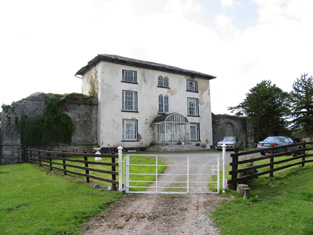
|
| Sopwell Hall | Apparently named after an English property, Sopwell in Hertfordshire, which was inherited by the Sadleir family. In 1655 a Cromwellian soldier, Colonel Thomas Sadleir, was granted Kinelagh Castle, county Tipperary, which he renamed Sopwell Hall. This property remained in Sadleir possession until it was inherited by Mary Sadleir who, in 1754, had married Frederick Trench of Woodlawn, county Galway, the parents of the 1st Lord Ashtown. The present house was built by Mary's father, Francis Sadleir, in the mid 18th century. Wilson refers to it as the residence of Mr. Sadlier in 1786. Sopwell Hall was left to Francis Trench, brother of 1st Lord Ashtown, who was living at Sopwell Hall in 1814. In 1837 Lewis records the Trenches in possession and writes that "on the demesne are the ruins of the ancient castle formerly occupied by the Sadleir family". The Ordnance Survey Name Books, in 1840, refer to Sopwell as "a spacious building, the residence of Stewart Trench". At the time of Griffith's Valuation the 2nd Lord Ashtown, son of Francis, was occupying the house, valued at £40 and held by him in fee. By 1906 Sopwell was valued at £80 and occupied by the Honourable Cosby G. Trench. The Trench family were still resident at Sopwell Hall in the 1970s. In 1840 the Ordnance Survey Name Books noted that Sopwell was one of the largest demesnes in the country. |

|
| Clifton | Lewis records Clifton as the seat of Captain Sheppard. The Ordnance Survey Name Books refer to it as "a modern building, the residence of Capt. Sheppard" in 1841. Arthur Sheppard [?] was the occupier at the time of Griffith's Valuation. He held the property from Thomas Pyke and the buildings were valued at £14.10 shillings. The National Inventory of Architectural Heritage records the present house as dating from 1868. |
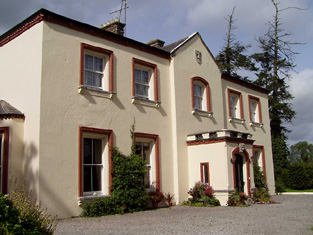
|
| Firmount | The seat of the Firman family in the late 18th century, occupied by Thomas P. Terman in 1814. The house is marked on the first edition Ordnance Survey map. The Ordnance Survey Name Books refer to it as "the mansion house of Firmount now falling into ruins, It appears to be a ruin by the time of Griffith's Valuation. The only buildings over £10 valuation were the Santa Cruise flour mill and house of Samuel Palmer. The Irish Tourist Association surveyor records "an extremely charming house converted from stabling" at Firmount and occupied by Major H.H. Deasy in the early 1940s. The surveyor states that the original house was destroyed by fire. | |
| Arbourhill | A house occupied by J. Antisell in 1837. The Ordnance Survey Name Books describe it as "a good dwelling house, the residence of Joseph Antisell" in 1840. It was valued at £10 when held by Thomas Pyke in fee at the time of Griffith's Valuation. There is still an extant house at the site. | |
| Gurteen | Lewis records J[ohn] Lalor as resident at Gurteen in 1837. He was a nephew of John Lalor of Crannagh and Long Orchard. The Orrdnance Survey Name Books also note Gurteen as his residence, describing it as "a good dwelling house". It was advertised for sale in July 1850. By the time of Griffith's Valuation,Michael Moyland held the house valued at £15+ and 234 acres in fee. George W. O'Brien of Gurteen, Parsonstown, owned 389 acres in county Tipperary in the 1870s. Mary Jane O'Brien held buildings valued at £12.10 shillings at Gurteen in 1906. |

|
| New Grove | Marked on the first edition Ordnance Survey map as New Grove, this house appears on the 25-inch map of the 1890s and is still known by the name, St Kierans. Occupied by J. W. Bayly in 1837 and described by the Ordnance Survey Name Books as " a good dwelling house, the residence of John Bayly" in 1840. It was occupied by Thomas Fetherston at the time of Griffith's Valuation and held from John Bailey. The buildings were valued at £19+. This property was advertised for sale in November 1851, the estate of John Washington Bayly. |

|
| Sraduff | Taylor and Skinner record Antisell Esq as the proprietor of Straduff in the 1770s. T. Antisell occupied Sraduff in 1837 and Christopher Antisell was resident in a house valued at £10+ in Sraduff in the early 1850s. The house was valued at £15+ in 1906 and was held by Monsell Antisell with 342 acres of untenanted land. This house is now a ruin. | |
| Kilcarren | A house occupied by Ralph Smith in 1814 and by A. Carew in 1837. The Ordnance Survey Name Books describe it as "a good dwelling house" in 1841. Alexander Carew, a descendant of Lynn Carew, held the property from Ralph Smith in the mid 19th century when the buildings were valued at £17+. The house is still extant and occupied. |

|
| Lackeen | Lackeen House is an early 18th structure attached to part of a 17th century house. John Baily was the proprietor of Lackeen Castle, Parsonstown [Birr], in 1814 and in the mid 19th century the house valued at £12.10 shillings was occupied by Hamilton English and held from Lord Cremore. This house is now unoccupied. |
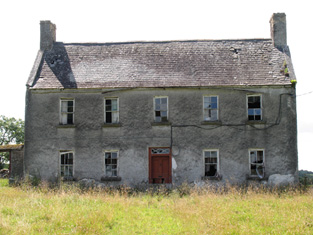
|
| Ballyquirk | In 1837 Lewis refers to the ruins of Ballyquirk castle "near which is a handsome modern house of that name". Colonel Henry Dwyer was the occupant in the mid 19th century, holding the house valued at £32 and 716 acres from Edward Newingham. |
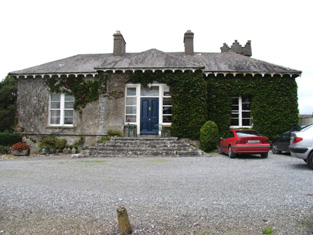
|
| Harvest Lodge | The Stoneys were resident at Harvest Lodge from at least 1837. Thomas Johnston Stoney, born 1780, fourth son of Thomas Stoney of Arran Hill held the property in fee at the time of Griffith's Valuation, when the house was valued at £30. Harvest Lodge was the home of J.M. Wilson in the 1870s. This house no longer exists. | |
| Curraghglass | J.W. Walsh is noted as the proprietor of Curraghglass in the Ordnance Survey Name Books of 1841. In the mid 19th century Thomas Meara occupied a house valued at £11 and held from the representatives of Jonathan Walsh. There is still a building located at this site. | |
| Firville | In 1841 the Ordnance Survey Name Books refer to "Ferville" as the residence of R.F. Drought. William S. Smith occupied the house in the mid 19th century which he held from Ralph Smith. It was valued at £15+. This building is still part of a farm complex. | |
| Belle Isle | A house overlooking the River Shannon, originally the home of a junior branch of the family it became the property of the 3rd Lord Avonmore through his second marriage to Cecilia O'Keeffe. The seat of 3rd Lord Avonmore in the mid 19th century held by him in fee and valued at £48. Belle Isle was occupied by Thomas Maunsell in 1814 and by Lord Avonmore in 1837. This house is no longer occupied. |

|
| Portland Park | A residence of the Stoney family from at least the 1770s, when it was purchased from the Earls of Antrim. Occupied by Richard Stoney in 1814 and by J. Chapman in 1837. In 1841 the Ordnance Survey Name Books described it as "a spacious building, the residence of Thomas B. Stoney with a great demesne". At the time of Griffith's Valuation he held the property in fee when the buildings were valued at £40. Portland Park remained in the possession of the Stoney family until it was burnt in 1936 (Irish Times, 11 May 1936). It is now a ruin. |
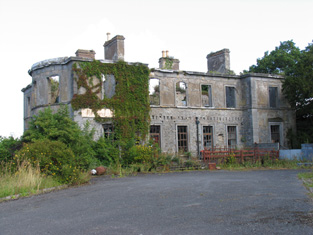
|
| Redwood | Marked on the first edition Ordnance Survey map as Moatfield House and on later maps as Redwood. Moate-field, Burris-a-kane, was the home of William Clarke in 1814. In 1841 the Ordnance Survey Name Books refer to it as "Moat Field, a good dwelling house the residence of Miss Clarke". In the mid 19th century Robert Daly held a house valued at £15 and 324 acres in Redwood from Lord Bloomfield. Redwood is still extant. | |
| Riverstown | The home of the Hackett family in the 19th century, occupied by Simpson Hackett in 1814 and in the 1830s and 1840s. Thomas Hackett was resident in the early 1850s and held the property from the Earl of Rosse. The house was valued at £29+. The Hacketts were still resident in the 1870s. This house is still extant and occupied and situated on the border of counties Tipperary and Offaly. In 2013 it was offered for sale. |
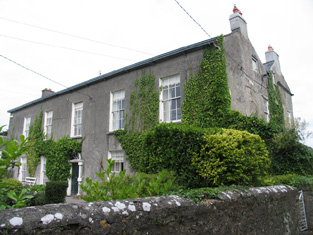
|
| Oak Park | The Ordnance Survey Name Books refer to Oakpark House as "a good dwelling house, the residence of Mr. Wm. Abernethy" in 1841. It was valued at £13+ and leased by William Abernethy from Colonel Hardress Lloyd at the time of Griffith's Valuation. It was advertised for sale in May 1875 as part of the estate of James Abernethy. A building is still located at this site. | |
| Croghan | In 1841 the Ordnance Survey Name Books refer to "Croughane House" as the residence of Francis Drought. Michael Mullarchy was leasing it from James Fleetwood at the time of Griffith's Valuation when Croghan was valued at £15. This house is still in use as a family residence. |

|
| Elm Hall | Lewis records Elm Hall as the residence of Peter Burke while the Ordnance Survey Name Books refer to it as that of "Counsellor Burke". By the time of Griffith's Valuation his son Joseph Burke was the occupier, holding the property in fee, the house was valued at £10. A farm building now occupies the site of Elm Hall. |
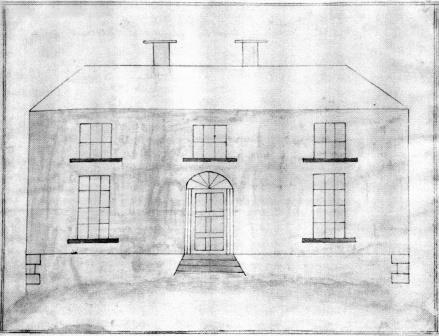
|
| Carrig | The National Inventory of Architectural Heritage describes this as a miller's house. In 1840 The Ordnance Survey Name Books refer to it as " a good dwelling house, the residence of Christopher Dignan, there is a good flour mill close by". William Abernethy held it from the Earl of Portarlington in the mid 19th century when the house was valued at £20. It is now a ruin. James Abernethy of Carrig owned 113 acres in county Tipperary in the 1870s. |

|
| Gurteen | Gurteen was the home of Willliam Smith in 1814 and of George Smith in 1837. At the time of Griffith's Valuation George Smith held the property from Lord Ashtown. The buildings were valued at £13. The Smiths were still living at Gurteen in the 1870s. Gurteen is now the centre of an agricultural college. http://www.gurteencollege.ie/index.html | |
| Lacka | Lewis records W. Cruess as proprietor of Lacka in 1837. On the first edition Ordnance Survey map a small house named Ash Grove is marked in the townland of Lacka S024 979. Later maps mark Lacka House at the crossroads. Griffith's Valuation names William N. Cruise as the occupier of a house valued at £10 in Lacka. He held the property and 335 acres from William Abernethy. The buildings were valued at £10. In the 1870s Samuel R. Cruess of Lacka owned 365 acres and William V. Cruise of Nenagh owned 121 acres. | |
| Baronne Court | The Ordnance Survey Name Books refer to Tinnakilly House and Observatory in the townland of Stonestown, the residence of Robert Robinson in 1840. The property was for sale in the Encumbered Estates' Court in February 1851. The sale details state that it was erected at a cost of £6,000 in 1830. It was altered by the Marshalls and renamed Baronne Court. Reverend Joseph Marshall is recorded as the occupier of the house valued at £53 at the time of Griffith's Valuation. The Reverend Joseph held the property in fee. William K. Marshall was recorded by Slater as the proprietor in 1894. This house is now demolished although the farm buildings still remain. |

|
| Wingfield | A house located just inside the county Tipperary border with county Offaly. The property belonged to John Shortt in the mid 18th century. When he died in 1768 his widow Frances (nee Spunner) married Jonathan Doolan. Wingfield was occupied by Jonathan's son Thomas Doolan in 1814 and in 1837. The Ordnance Survey Name Books refer to it as the residence of [Paliner?] Thomas Doolan in 1840. By the time of Griffith's Valuation Henry Spunner was resident. He held the property from Jonathan Short and the buildings were valued at £20. Richard Thomas Croasdaile and his sister Margaret occupied the house in 1901. This house is now a ruin. |

|
| Coorevin | Lewis records Cooreavan as the property of R. Hall in 1837. In 1840 the Ordnance Survey Name Books indicate that it was occupied by "Mr Gorey Baker, Burresokane". Jeremiah P[ierce] Scully was the occupier at the time of Griffith's Valuation, holding the property from the representatives of Robert Hall. The buildings were valued at £11. A building is still located at this site. | |
| Uskane | Carrol Esq was resident at "Iscane" in the 1770s and 1780s. In 1837 R. Hall was the proprietor of Uskane House. In 1840 the Ordnance Survey Name Books note it as "a good dwelling house, the residence of Mr. Kent". It was held by the representatives of Robert Hall in fee at the time of Griffith's Valuation when the house was valued at £8. This house is still in use as a residence. |
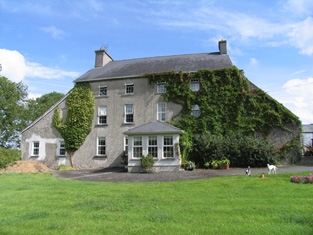
|
| Slevoir | Lewis records R. Monsell as resident at Slevoir in 1837. The Reverend Francis Synge was the occupier at the time of Griffith's Valuation, holding the property from the representatives of Mr Steele. The buildings were valued at £34. The National Inventory of Architectural Heritage states that the present house was built in the Italianate style in the 1870s for Lieutenant Colonel J.F. Hickey by John McCurdy. In the early 1940s General Carlos J. Hickie was the owner and the house contained very beautiful furnishings and valuable family pictures according to the Irish Tourist Association surveyor. This house sold for over £3 million in 2000 and was offered for sale again in 2011. |
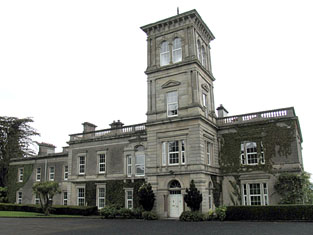
|
| Derrinvohil | This house was not built at the time of the first Ordnance Survey. It bears the name of a townland but was originally located in the townland just to the west of Derrinvohil. The townland boundary has now altered and the house is in the townland of Derrinvohil. It was built by James Jocelyn Poe in 1845. Valued at £17 at the time of Griffith's Valuation and held from the Messrs Saurin. The house continues to function as a residence. |
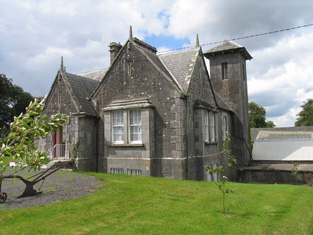
|
| Castle Sheppard | The Sheppards were living here from at least the 1770s.In 1786 Wilson refers to Castle Sheppard as the seat of "Mr. Shepherd". It was the home of a junior branch of the family. William Sheppard was resident in 1837 and in the early 1850s when the house was valued at £26 and held from Lord Ashtown. William died at Castle Sheppard in 1852 without heirs and both his brothers died unmarried in India. Valued at £18 in 1906 and occupied by the Honourable Cosby G. Trench. This house is now a ruin. | |
| Somerset | The National Inventory of Architectural Heritage states that this house was built in 1875. It appears to have replaced an earlier house also known as Somerset marked on the first edition Ordnance Survey map circa 1840. In 1841 the Ordnance Survey Name Books refer to Somerset as "a small demesne and good dwelling house, the residence of Mr. Going". It was the home of John O'Meara in the mid 1870s. In 1906 William H. O'Meara occupied a house valued at £12+ in the townland of Abbeville. |
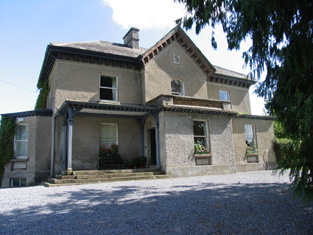
|
| Annagh | In 1841 the Ordnance Survey Name Books describe Annagh as "a good dwelling house, the residence of John Kennedy". At the time of Griffith's Valuation, it was valued at £10, occupied by John Kennedy and held from George Kinahan. In 1906 held by the representatives of George Bolton. This house is now a ruin. | |
| Woodfield House (Donanaghta) | At the time of Griffith's Valuation, Timothy Egan was leasing a property valued at £7 from the Clanricarde estate. On the 25-inch map of the 1890s the house in this townland is labelled Woodfield. It is still extant and occupied. The first edition Ordnance Survey map notes an old brewery nearby. |
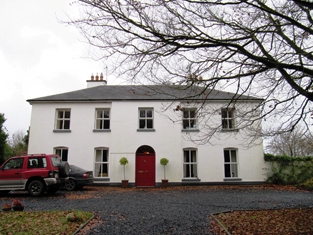
|
| Palmerstown Cottage (Lodge) | At the time of Griffith's Valuation, Timothy Joyce was leasing this property from the Palmer estate when it was valued at £5. It is still extant but not currently occupied. | |
| Rockview (Dorrha) | In 1840 the Ordnance Survey Name Books refer to Rockview House as "a good mansion house, the residence of Captain Corrigan". By the time of Griffith's Valuation this house was occupied by John Hemsworth, leasing from Mary Nunn and representatives of Richard Donovan. The buildings were valued at almost £7. Rockview House is still extant. |
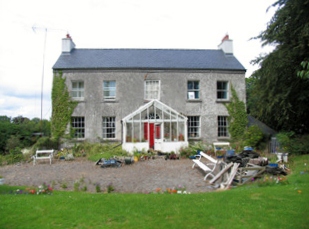
|
| Ross Cottage/House (Dorrha) | In 1841 the Ordnance Survey Name Books refer to Ross Cottage as "an elegant built cottage, the residence of Mr. Smyth", the proprietor of which was R. Hemsworth. The house is labelled as "Ross House" on both the 1st and 25-edition Ordnance Survey maps. By the time of Griffith's Valuation, it was occupied by Thomas Hernon, leasing from John J. Hemsworth and the buildings were valued at almost £8. The house is still extant and occupied. |
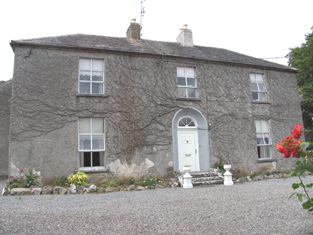
|
| Roden House | In 1841 the Ordnance Survey Name Books describe Roden House as "a good dwelling house". C.W. Hemsworth is noted as the proprietor. At the time of Griffith's Valuation, it was occupied by Thomas R. Deane, leasing from Thomas Hackett, when the buildings had a valuation of almost £3. The National Inventory of Architectural Heritage dates this property to 1784. It is still extant and occupied. |
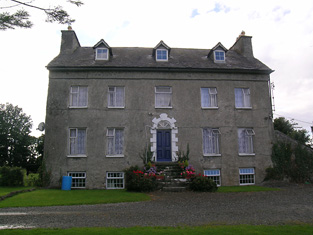
|
| Loughkeen Glebe | In 1840 the Ordnance Survey Name Books describe the Glebe at Loughkeen as "a good dwelling house the residence of Rector Synge". At the time of Griffith's Valuation, it was leased by Reverend Francis Synge from the Ecclesiastical Commissioners and valued at £23+. It is still extant and occupied. |
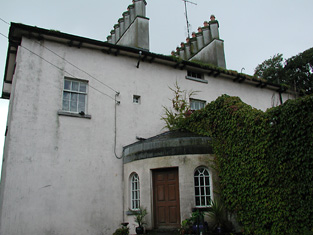
|
| Ivy Hall (Loughkeen) | The Ordnance Survey Name Books refer to Ivy Hall as the residence of Richard Palmer in 1840. By the time of Griffith's Valuation, it was occupied by Mary Anne Palmer, who was leasing from William Abernethy, and valued at almost £8. Ivy Hall is still extant and occupied. |
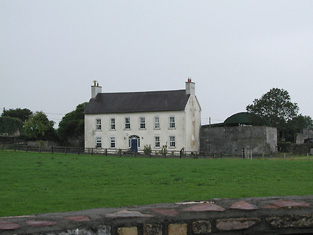
|
| Rockville (Loughkeen) | The Ordnance Survey Name Books refer to Rock Ville House in the parish of Loughkeen as the residence of Mr. S. Lloyd in 1841. At the time of Giffith's Valuation, a house in this townland valued at £10 was occupied by William Kent, leasing from Jane Downs. On the 25-inch map of the 1890s this house is labelled Carrig Cottage. It is still extant. | |
| Clonfinane House | In 1841 the Ordnance Survey Name Books refer to a house in the townland of Clonfinane as Moorefield House. There is reference to a communication from the Earl of Portarlington that he did not know of any such place on his estate with a following note by John O'Donovan stating "but your tenant built a house and gave it a name"! The house is described as " a good dwelling house, the residence of Maunsell Antisell". However, on the 1st edition Ordnance Survey map, the house is labelled "Clonfinane House" perhaps indicating that Lord Portarlington prevailed. At the time of Griffith's Valuation, the house in this townland is occupied by the representatives of Jonathan Walsh and valued at almost £4. A house and farm are still extant at the site. |

